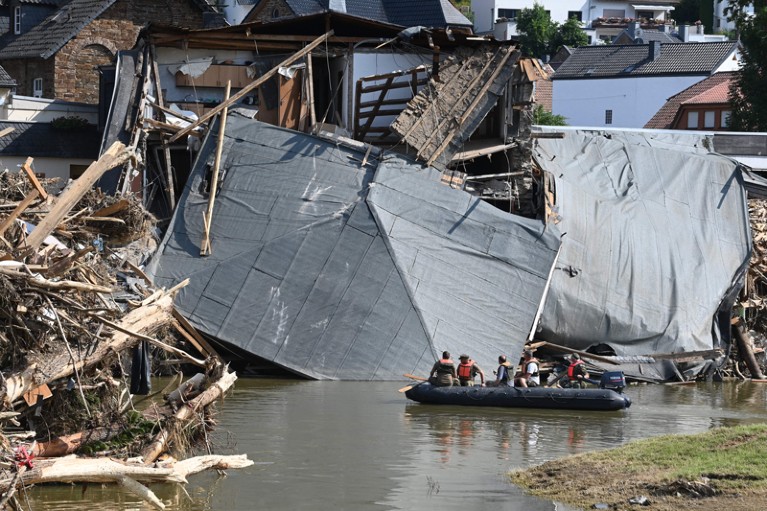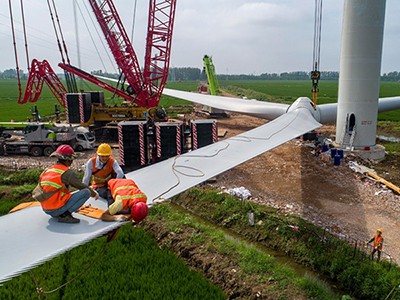
Devastating floods that hit Germany last July were made more likely by the warming climate.Credit: Christof Stache/AFP/Getty
Late last year, the major climate summit in Glasgow, UK — the 26th Conference of the Parties to the United Nations climate convention (COP26) — injected much-needed momentum into the political and business community in the fight to stop climate change. The year ahead represents an opportunity for scientists of all stripes to offer up expertise and ensure that they have a voice in this monumental effort.
Science is already baked into the UN’s formal climate agenda for 2022. In February, the Intergovernmental Panel on Climate Change (IPCC) is scheduled to release its assessment of the latest research into how climate warming is affecting people and ecosystems; a month later, the panel is set to provide an analysis of the options for curbing emissions and halting global warming. Combined with last year’s report on climate science, the governments of the world will have a solid review of the state-of-the-art of research on climate change. But the research community’s work stretches far beyond the IPCC.
At the top of governments’ climate agenda is innovation. Existing technologies such as wind and solar power, whose price has plummeted over the past decade, and more-efficient lighting, buildings and vehicles will help to reduce emissions. But if green energy is to push out fossil fuels and fulfil the rising demand for reliable power in low-income countries, scientists and engineers will be needed to solve a range of problems. These include finding ways to cut the price of grid-scale electricity storage and to address technical challenges that arise when integrating massive amounts of intermittent renewable energy. Research will also be required to provide a new generation of affordable vehicles powered by electricity and hydrogen, and low-carbon fuels for those that are harder to electrify, such as aircraft.
Even in the most optimistic scenarios, such clean-energy deployments are unlikely to be enough to enable countries to keep their climate commitments. More innovation will also be needed — for example, in the form of technologies that can pull carbon dioxide out of the atmosphere. These have yet to be tested and demonstrated at any significant scale. Governments and funders also need to support scientists in efforts to understand the safety and efficacy of various controversial geoengineering technologies — methods for artificially cooling the planet, such as the addition of particles to the stratosphere to reflect sunlight back into space — if only to determine whether there is sense in even contemplating such alternatives.
Give research into solar geoengineering a chance
There are signs of renewed support for research and innovation in helping to address climate change. In Glasgow, 22 countries, as well as the European Commission (EC), announced plans to cooperate on innovation focused on greening cities, curbing industrial emissions, promoting CO2 capture and developing renewable fuels, chemicals and materials. The EC has also announced efforts to drive new funds into demonstration projects to help commercialize low-carbon technologies. And China, currently the world’s largest emitter of greenhouse gases, is creating a vast research infrastructure focused on technologies that will help to eliminate carbon emissions.
China creates vast research infrastructure to support ambitious climate goals
In the United States, under President Joe Biden, the Democrats have also made innovation a linchpin of efforts to address climate change. A bipartisan bill enacted in November will expand green-infrastructure investments, as well as providing nearly US$42 billion for clean-energy research and development at the US Department of Energy over the next 5 years, roughly doubling the current budget, according to the Information Technology and Innovation Foundation, a think tank in Washington DC. Another $550 billion for climate and clean-energy programmes is included in a larger budget bill that Democrats hope to pass this year. Economic modelling suggests that the spending surge could help to lower emissions in the coming decade while teeing up technologies that will be crucial to eliminating greenhouse-gas emissions in the latter half of the century.
In addition to enabling green innovation, scientists have an important part to play in evaluating climate policies and tracking commitments made by governments and businesses. Many of the initiatives that gained traction at COP26 need science to succeed. That includes evaluating how climate finance — money that wealthy nations have committed to help low-income nations to curb emissions and cope with climate change — is spent. Research is also needed to understand the impacts of carbon offsets and carbon trading, for which new rules were agreed at COP26.
COP26 climate pledges: What scientists think so far
Climate science, too, must continue apace, helping governments and the public to understand the impact of climate change. From floods in Germany to fires in Australia, the evolving field of climate attribution has already made it clear that global warming is partly to blame for numerous tragedies. Attribution science will also feed into an ongoing geopolitical debate about who should pay for the rising costs of climate-related natural disasters, as many low-income countries seek compensation from wealthy countries that are responsible for the bulk of the greenhouse-gas emissions so far.
These and other issues will be discussed again in November at COP27 in Sharm El-Sheikh, Egypt, where it will be crucial to make sure that everyone has a voice and that research supports climate monitoring and innovation everywhere, not just in richer nations.
A new agreement made at COP26 that requires governments to report annually on their climate progress should help to maintain pressure on them to act on climate change. But science and innovation will be equally important to driving ever-bolder climate policies.

 COP26 climate pledges: What scientists think so far
COP26 climate pledges: What scientists think so far
 China creates vast research infrastructure to support ambitious climate goals
China creates vast research infrastructure to support ambitious climate goals
 Give research into solar geoengineering a chance
Give research into solar geoengineering a chance






